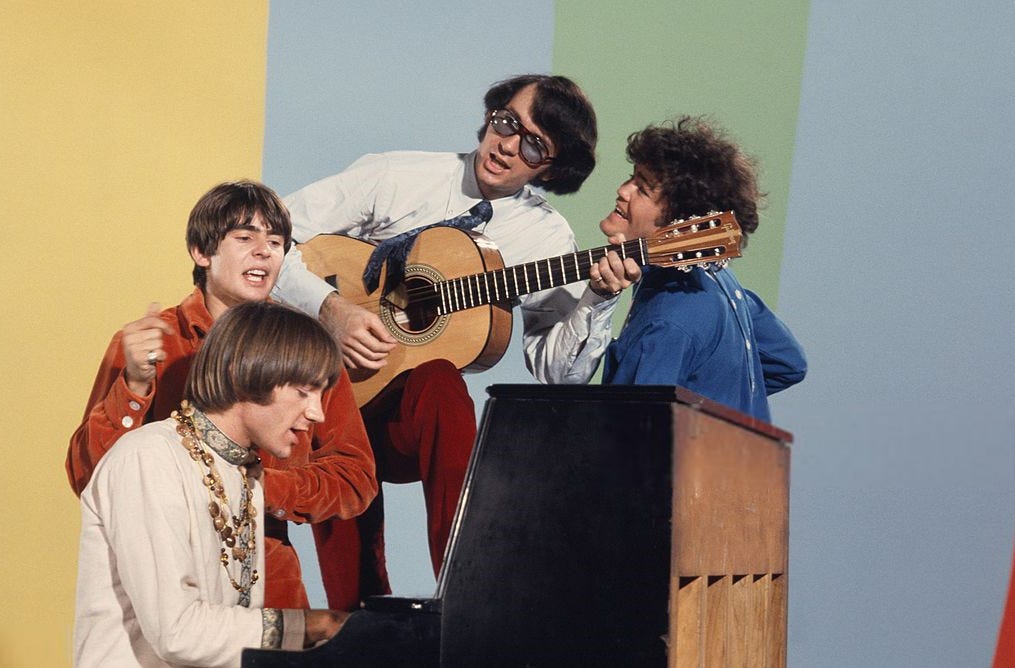By
It may be difficult to imagine now, but there was a time in the 1960s when a pop band, in a single year, outsold the Beatles and the Rolling Stones combined — and not even a real band at that. Really, the group was four strangers thrown together on a TV show about a band all living in an imaginary group house. Both the band and the show — the Monkees — were instantly and wildly popular among a certain set of American kids.
Those kids are now in late middle age (or older), and that band is finally going home. In 2012, lead singer Davy Jones, at 66 years old, was the first to die ; on Thursday, 77-year-old Peter Tork died from a rare form of cancer. Along with Mike Nesmith, Tork was one of the two real musicians in the quartet. (Stephen Stills had recommended Tork for the role after being passed over for beingtoo snaggle-toothed.) The other two Monkees — Jones and drummer Micky Dolenz — were actors.
The most technically skilled in the group, Tork had trained classically and played guitar, banjo and French horn and was particularly talented on keyboards, though he was best known on the TV show as the band’s bassist. Nesmith has been quoted as saying that Tork, not himself, should have been the band’s main guitarist.
When it was revealed that the Monkees sang their songs but did not play the instruments on their first album, there were understandable catcalls of “Prefab Four,” a reference to the Beatles’ nickname “The Fab Four.” The session players behind the scenes who did the musical lifting were some of the industry’s best; so was the group of songwriters, which included Carole King, Gerry Goffin, Neil Diamond and Harry Nilsson. On the show, Tork played the role of lovable dunce, a foil for Nesmith’s common sense, Dolenz’s antics and Jones’s endless wooing of (and by) young women.
The Monkees managed to gain control of their musical direction after their second album, “More of the Monkees,’’ and began eschewing the session musicians previously foisted upon them. The band finally sang and played on their third album, “Headquarters,” which produced no hits but began to showcase the group’s talents. (“Headquarters,” like all of the band’s first four albums, went double platinum.) Tork’s many skills then came in quite handy in the recording studio: That’s Tork on the iconic piano intro to “Daydream Believer,” he is at the harpsichord on “The Girl I Knew Somewhere,” and his riffing on “You Told Me” would still test many banjoists today.
After he left the group in 1968, Tork engaged in various endeavors — a friend recalls working with him as a singing waiter in Los Angeles. Tork got as far as London, where he played banjo for George Harrison’s “Wonderwall” film, but in the early 1970s, he returned to California, where he taught music and other subjects at a host of local schools. In the 1980s, when MTV began re-airing the Monkees series, a new audience emerged and reunion tours were held. Tork performed in these until as recently as 2016.
My own fascination with the band dates to 1966, when, at age 9, I was hit amidships by the TV show. Like many kids my age (some of whom might not admit it now), “Meet the Monkees” was my first album. To me, the Monkees were the zenith — the vibe, the songs, the zany humor, everything about them made me and everyone I knew the target demographic of the era. I ended up following a musical path and have, for the past 20 years, been a part of Beach Boy Brian Wilson’s band.
How to explain the Monkees’ unlikely staying power, their stalwart presence on oldies radio? I think many baby boomers, obviously, found them accessible and relatable, certainly unthreatening. But more importantly, Tork once said the band had real chemistry — not just any four young men could have done what they did. I think there was a sense of vindication they shared among themselves that critics had turned up their noses at the supposed ineptitude of the Prefab Four and were proved wrong — in which case, all among us who are judged and found to have come up short still have a chance.
Most of all, there are the sounds of those hits, pristine in their peculiar moment, which when matched to those particular voices, still succeed. They form a part of the soundtrack of many baby boomers’ lives, a validation of their memories, making believers of us all.
Probyn Gregory is a veteran freelance musician who lives in Tujunga, Calif., with his wife and son. He will play guitar, banjo and trumpet with “The Monkees Present: The Mike & Micky Show,” when it begins a three-week tour this Thursday.

No comments:
Post a Comment